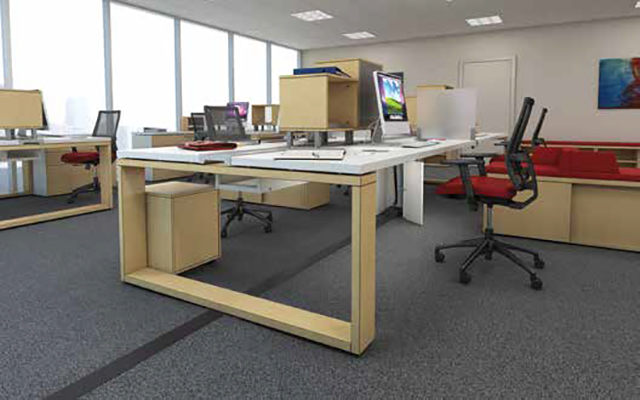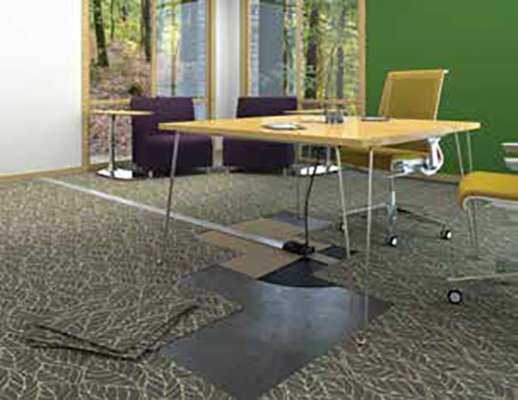As Our Workforce Changes, Tech Managers Must Keep Up

For years now, agility has been the watchword in business. Near-constant evolution in technology has forced companies of all sizes to not only respond quickly to seismic landscape shifts but accept them as a constant. And while it’s easy to think of the need to anticipate change in strategic terms, flexibility is no less pressing when it comes to infrastructure. In fact, thanks to an array of pressures, the workplace is itself evolving.
Connectrac tries to anticipate its clients’ future needs, working with specifiers, facility managers, and IT/AV managers to offer a variety of flexible wireway layouts. Demographic trends are partly responsible. Millennials are entering the workforce in ever-greater numbers—the Bureau of Labor Statistics predicts these workers, born between 1976 and 2001, will comprise a majority of the labor pool by 2015—and they have new ideas about the ideal office looks like. Younger workers, research suggests, prefer a more casual and more collaborative work environment. That means fewer traditional conference rooms and in their place, flexible spaces that can comfortably accommodate a few individuals or an impromptu meeting.
“Government, education, corporate—across every segment we’re seeing the densification, the breakout meeting spaces, the casual meeting spaces,” says Clint Strong, CEO of connectivity solutions provider Connectrac. Indeed, a 2013 survey of 500 North American companies by commercial real estate association CoreNet Global found that 27 percent were in the process of increasing flexibility in their office layouts and another third were adding meeting and collaboration space. “All the predictions that were being made in the areas of facilities planning and design back eight, ten years ago, they’re all coming together in a huge way.” Strong ought to know—his company’s success is predicated on keeping pace with rapidly changing needs in enterprise infrastructure.
“There’s so much change in the use of spaces,” Strong says. “What are [used as] workstations today are going to be conference rooms or private offices in six months to a years’ time.”
And it’s not simply a matter of shuffling desks and couches. Power and connectivity needs have to be addressed too, and all with an eye toward further change down the road.
“There are literally billions of square feet of older, even historic, buildings that were designed and constructed at a time when technology needs were minimal,” Strong says, recalling a simpler time when power and Cat5 cable was all that was required. Back then, infrastructure solutions could be viewed as long-term.
“In the older days,” Strong says, core drilling, and placing trenches and conduits beneath floor slabs seemed like sensible ways to provide the necessary wiring and device support. “Well now, there’s so much change in those spaces, they try to avoid it because they know, Hey, the technology for this set up is going to change, and not only that but where we put this table to begin with is going to change. Everything has to be so flexible.”
A daily selection of features, industry news, and analysis for tech managers. Sign up below.

Mobility is one of the driving factors in flexible workspace design. Featured above is the Connectrac In-Carpet Wireway solution. Not only that, but infrastructure needs have advanced far beyond providing Cat5 cable and power. VGA, HDMI, and fiber optic are required too, frequently throughout entire buildings. And these are just the technologies prevailing today.
“It’s hard to anticipate what needs are going to be there from a technology standpoint,” Strong says. “If you have an existing core drill, even if it’s in the right place for your reconfigured space, it won’t have the right connectivity. It may not have the right power it may not have the right cabling, so you still have to go back and redo it.”
Connectrac tries to anticipate its clients’ future needs, working with specifiers, facility managers, and IT/AV managers to come up with a variety of wireway layouts based on alternate configurations of the space in question.
“We’ll work with [clients] to figure out the most likely configurations of their space in order to aim the devices so that they’re going to support the functions say, 80- or 90-percent of the time,” Strong says. “It doesn’t hit 100-percent of the layout options and that’s frustrating to us, so we’re developing solutions that can really be flexible, where if people need to change their layout, they can pop the electrical device out and change its location along the wireway.”
Mobility is another factor driving the need for workplace flexibility. Despite the very real security and support worries it raises, the BYOD phenomenon is growing, and consensus says its here to stay. A 2013 survey by cloud computing firm Citrix found 74 percent of businesses actively support or encourage the use of personal devices. Gartner is bullish enough on BYOD to predict that within three years, 50 percent of businesses will actually require employees to supply their own devices. To keep pace, facilities and IT managers need to supply power and connectivity to an ever-larger pool of devices. This is especially true in spaces dedicated to meetings and presentations.
“People are connecting their iPads and their notebook computers, and presenting,” Strong says. “Somebody will present something and then somebody else will flip around and present [on a different device]. It’s really a multi-platform environment.”
Even if BYOD is not an issue, tablet use is growing at the enterprise level, with sales to businesses expected to account for nearly 20 percent of the market this year. And while Apple’s iPad still dominates corporate sales, Android is gaining ground. There’s so much room for growth in corporate tablet sales, according to an IDC report, that even the Windows Surface will grab a chunk of the market as companies already running Windows opt for ease of integration.
Given that meeting spaces need to accommodate guests’ as well as employees’ devices, it’s not enough to base connectivity needs on internal device inventory. Between visitors and BYOD, just about every device on the market is in play.
“If someone has a new notebook,” Strong says, “chances are, it’s going to require an HDMI to connect to the flat-panel in the wall, whereas if someone has a device that’s two or three years old, perhaps they still need a VGA connection.
“It’s all about what tools people are bringing to the table.”
Brooklyn-based David Zuckerman is a regular contributor to AV Technology magazine.
